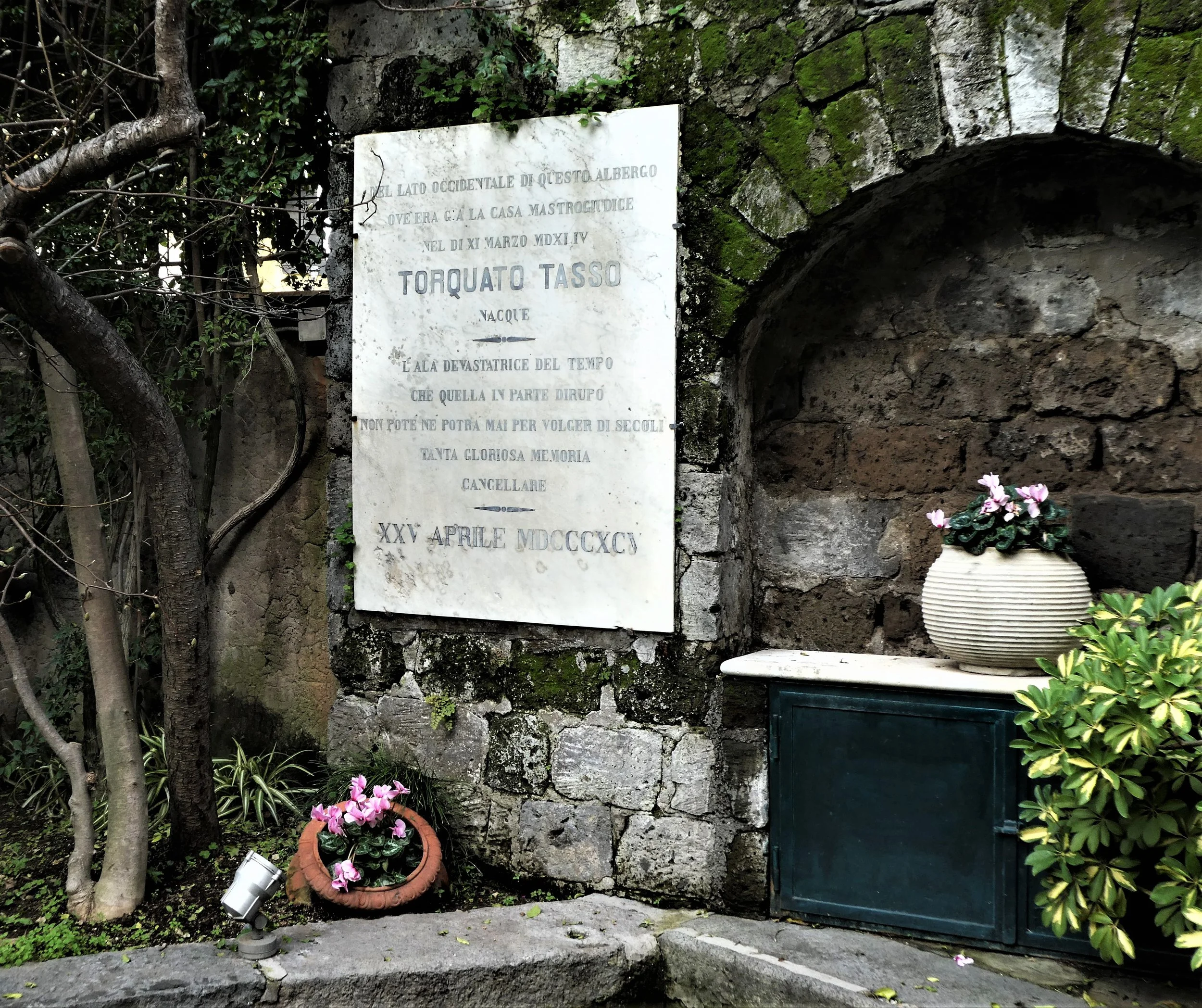Terrace of the Hotel Syrene, Sorrento
A Rainy Day in Sorrento
When the sun is warm and the scent of lemons lingers along the streets, and Vesuvius seems filled with benevolence rather than brimstone across the bay, and the excursion boats leave long silver wakes on the way to Capri, it is easy to be dazzled by beauty and dreamily miss some of Sorrento’s important landmarks. But on a dark, wet, and blustery day, you might find yourself in the town’s main square, as I did, struggling to keep your umbrella from turning inside-out, in the lee of a sizeable marble statue. The subject is a gentleman dressed in fashionable 16th century garb: doublet and cape, pumpkin breeches, snug hose accentuating shapely legs. He gazes thoughtfully into the distance, unperturbed by the bird perched on his head. I knew who he was, of course, because, after all, I was standing in the piazza bearing his name, and the statue’s plinth announced it as well: Torquato Tasso.
Tasso’s Statue, in Piazza Tasso
Torquato Tasso – along with Dante, Petrarch, Ariosto and others, the name seemed to belong to a sort of Italian poetic pantheon, but I realized I didn’t quite know why. Dante followed Virgil to hell and Beatrice to Paradise in the Commedia, of course; Petrarch lamented loving the untouchable Laura in his sonnets; Ariosto sang the story of Orlando furiously waging war with the Saracens. But what was Tasso’s claim to fame?
As I continued my damp progress around town, my ignorance became more and more oppressive. It was clear that Torquato Tasso was a superstar in Sorrento. I seemed to encounter him everywhere. In Sorrento’s Cathedral I nearly tripped over his baptismal font, complete with commemorative plaque. Another memorial in the elegant gardens of the Hotel Imperial Tramontano seemed to hint that the house where he was born in 1544 had mostly tumbled into the sea, but the rest had been incorporated into the hotel, adding that the “devastating wing of time” could never cancel his “glorious memory”. A poem by Torquato’s father, Bernardo, is inscribed on the west wall of the hotel, overlooking the port.
The Baptismal Font
After stopping at Bar Tasso for a coffee while a rain squall passed, I walked a block down Via Tasso, and, turning left, found myself in front of Cornelia Tasso’s house. Cornelia, the marble plaque on the façade explained, was Torquato’s older sister. Next door, the fascinating “Museo Bottega della Tarsia Lignea” contained exquisite examples of antique inlaid wood furniture, several pieces unexpectedly depicting episodes in Torquato Tasso’s life. And, strangely, residing dustily in a glass case, there was a 1689 edition of Tasso’s Jerusalem Liberated, which, as I learned later, is the poet’s great work, and the basis (along with an eventful and rather tragic life) of his lasting fame.
He’s Everywhere
Well. Clearly, I was destined to learn much more of Torquato, and I was a bit alarmed to think that my researches would require that I read Jerusalem Liberated (or La Gierosalemme Libberata, as the ancient title page styles it), especially when I found that the poem consists of nearly 2000 stanzas and over 15,000 lines. But over the next couple of weeks, I found myself engrossed in Tasso’s fantastic romance, based very loosely on the First Crusade led by Godfrey of Bouillon and other Frankish knights. Besides Moslem armies, the Crusaders must contend with voluptuous temptresses who distract them from their mission, warrior princesses, sorcerers, terror-filled enchanted forests, and much, much more. Even in a 19th century translation, it’s a riveting story. No wonder Tasso was a best-seller in his own time.
The 1689 Edition
But Tasso was famous as much for his own tumultuous life as for his poetry. In those days, writers, poets, artists and musicians usually lived as courtiers with the rulers of Italian city-states. They were often honoured members of the court, bringing prestige to the city. Tasso’s most lasting involvement was with the court of Duke Alfonso II of Ferrara. Theirs was a stormy relationship. Tasso was suspicious and paranoid, often complained of imagined slights, and occasionally even became violent. When he threatened a servant with a knife, the Duke first arrested him, but then, as a rest cure, took his distracted poet to his country seat of Belriguardo. There, something happened – perhaps an unwise love affair – that made Tasso flee to Sorrento and the care of his sister Cornelia. He couldn’t stay away from Ferrara, though. After he returned, he became so violent that the Duke, believing him insane, had him confined to the madhouse of St. Anne. There he remained for seven years, writing. He was eventually released into the custody of Vincenzo Gonzaga, Prince of Mantua.
The Memorial Plaque in Hotel Tramontano’s Garden
Mantua didn’t please him, however, and he went on a lonely odyssey from one great court to another, always honoured as a genius, but finding no happiness. At length he reached Rome, where Pope Clement VIII offered to crown him Poet Laureate of Rome. It was too late, though: worn out with wandering and his exhausting madness, he died in the Monastery of Sant’Onofrio in Rome, aged 51.
Goethe wrote a play about him, Delacroix and Poussin painted scenes from his poem, and he inspired operas by Handel and Donizetti. But perhaps the best way to remember Torquato Tasso is to take a walk in the rain, in Sorrento.
The Scent of Lemons Lingers
© Text © 2020 by Joe Gartman; Photographs © 2020 by Patricia Gartman. First published in Italia! Magazine, May 2020






